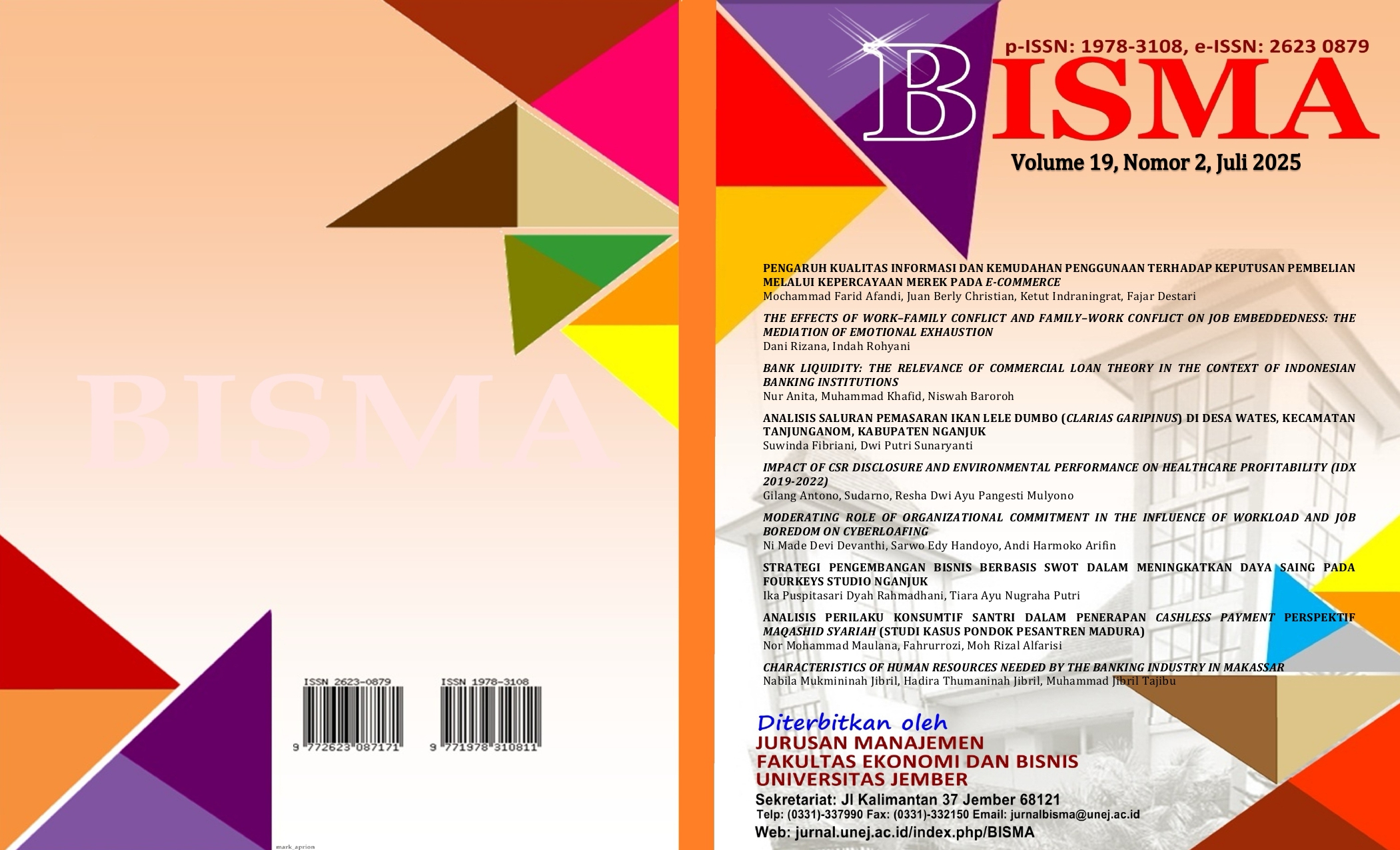BANK LIQUIDITY: THE RELEVANCE OF COMMERCIAL LOAN THEORY IN THE CONTEXT OF INDONESIAN BANKING INSTITUTIONS
DOI:
https://doi.org/10.19184/bisma.v19i2.53763Keywords:
Liquidity, Leverage, Size, Profitability, Commercial Loan Theory, BankingAbstract
This study investigates the effect of leverage, profitability, and firm size on the liquidity of banking firms listed on the Indonesia Stock Exchange (IDX), with particular attention to the moderating role of firm size. This study uses a quantitative approach. The population of this study is banking companies listed on the Indonesia Stock Exchange from 2020 to 2024. The sampling technique uses purposive sampling, which produces a sample of 235 analysis units. Data collection in this study uses documentation techniques. Data analysis uses panel data regression and moderated regression analysis (MRA). The findings reveal that leverage significantly negatively affects liquidity, supporting the principles of Commercial Loan Theory, which emphasizes maintaining liquidity through short-term, self-liquidating assets. The results demonstrate that firm size significantly enhances liquidity, while profitability shows no significant direct effect. Moreover, firm size moderates the relationship between leverage and liquidity in a positive direction, suggesting that larger banks can better withstand the liquidity risks associated with high leverage. Conversely, firm size negatively moderates the relationship between profitability and liquidity, implying that larger banks may reinvest profits into long-term, less liquid assets. This study contributes to the financial management literature by revisiting the relevance of Commercial Loan Theory in the context of Indonesian banking institutions. By integrating firm size as a moderating variable, the research offers a novel perspective on how internal firm characteristics influence the relationship between financial structure and liquidity. Furthermore, using the quick ratio to measure bank liquidity introduces a conservative and less common approach in banking studies, enriching the methodological diversity in liquidity research.
Downloads
References
Akhtar, M. F., Ali, K., & Sadaqat, S. (2011). Liquidity risk management: a comparative study between conventional and Islamic banks of Pakistan. Interdisciplinary Journal of Research in Business, 1(1), 35–44.
Al-Harbi, A. (2017). Determinants of banks liquidity: evidence from OIC countries. Journal of Economic and Administrative Sciences, 33(2), 164–177. https://doi.org/10.1108/jeas-02-2017-0004.
Al-Khouri, R. (2012). Bank characteristics and liquidity transformation: The case of GCC banks. International Journal of Economics and Finance, 4(12).
Al‐Homaidi, E. A., Tabash, M. I., Farhan, N. H., & Almaqtari, F. A. (2019). The determinants of liquidity of Indian listed commercial banks: A panel data approach. Cogent Economics and Finance, 7(1), 1–21. https://doi.org/10.1080/23322039.2019.1616521.
Ajanthan, A.(2013). A Nexus Between Liquidity & Profitability: A Study Of Trading Companies In Sri Lanka. European Journal of Business and Management, 5(7), 221–237.
Alter, A., & Elekdag, S. (2020). Emerging market corporate leverage and global financial conditions. Journal of Corporate Finance, 62, 101590.
Beck, T., Demirgüç-Kunt, A., & Maksimovic, V. (2008). Financing patterns around the world: Are small firms different? Journal of Financial Economics, 89(3), 467–487.
Bekhet, H. A., Alsmadi, A. M., & Khudari, M. (2020). Effects of internal and external factors on profitability of Jordanian commercial banks: Panel data approach. International Journal of Financial Research, 11(5), 359–375.
Berger, A. N., & Bouwman, C. H. S. (2009). Bank liquidity creation. The Review of Financial Studies, 22(9), 3779–3837.
Bordeleau, É., & Graham, C. (2010). The impact of liquidity on bank profitability. Bank of Canada.
Chen, T.-H., Lee, C.-C., & Shen, C.-H. (2022). Liquidity indicators, early warning signals in banks, and financial crises. The North American Journal of Economics and Finance, 62, 101732.
Chen, Y.-K., Shen, C.-H., Kao, L., & Yeh, C.-Y. (2018). Bank liquidity risk and performance. Review of Pacific Basin Financial Markets and Policies, 21(01), 1850007.
Claessens, S., Ghosh, S. R., & Mihet, R. (2013). Macro prudential policies to mitigate financial vulnerabilities in emerging markets. Dealing with the Challenges of Macro Financial Linkages in Emerging Markets, 155–178.
Diamond, D. W., & Rajan, R. G. (2001). Liquidity risk, liquidity creation, and financial fragility: A theory of banking. Journal of Political Economy, 109(2), 287–327.
Diaz, J. F., & Pauchet, B. (2022). Determinants of Publicly-Listed Firms’ Liquidity: Evidence from French and Taiwanese Banks. Journal of East-West Business, 1–28.
Enekwe, C. I., Agu, C. I., & Eziedo, K. N. (2014). The effect of financial leverage on financial performance: Evidence of quoted pharmaceutical companies in Nigeria. IOSR Journal of Economics and Finance, 5(3), 17–25.
Ferreira, M. A., & Vilela, A. S. (2004). Why do firms hold cash? Evidence from EMU countries. European Financial Management, 10(2), 295–319.
Gomez, F., & Vo, Q.-A. (2016). Liquidity management in banking: The role of leverage. EFMA B2017 Annual Meetings, European Financial Management Association.
Ismail, R. (2016). Impact of liquidity management on profitability of Pakistani firms: A case of KSE-100 Index. International Journal of Innovation and Applied Studies, 14(2), 304.
Isshaq, Z., & Bokpin, G. A. (2009). Corporate liquidity management of listed firms in Ghana. Asia-Pacific Journal of Business Administration, 1(2), 189–198. https://doi.org/10.1108/17574320910989122.
Kaur, S. S., & Silky, J. (2013). A study on liquidity and profitability of selected indian cement companies: a regression modeling approach. International Journal of Economics, Commerce and Management, 1(1), 1–24.
Laeven, M. L., Ratnovski, M. L., & Tong, M. H. (2014). Bank size and systemic risk. International Monetary Fund.
Lalithchandra, B. N. (2021). Liquidity Ratio: An Important Financial Metrics. Turkish Journal of Computer and Mathematics Education (TURCOMAT), 12(2), 1113–1114.
Lim, K., & Mei, Y. (2018). Impact of Macroeconomic and Bank Specific Factors on Liquidity of Commercial Banks In Malaysia. International Journal of Accounting, Finance and Business, 3(12), 76–90.
Loo, M. A. (2007). A survey of liquidity management approaches and their effect on profitability of commercial banks in Kenya. University of Nairobi.
Melese, N. (2015). Determinants of banks liquidity: Empirical evidence on Ethiopian commercial banks. Unpublished MSc Thesis, Addis Ababa University.
Nugraha, I. A., & Syaichu, M. (2022). Analisis Pengaruh Price Earnings Ratio (PER), Non Performing Loan (NPL), Bank Size, Debt To Equity Ratio (DER), Kepemilikan Institusional Terhadap Kepercayaan Investor (Studi Kasus Pada Perbankan Konvensional Yang Terdaftar Di BEI Periode 2016 2020). Diponegoro Journal of Management, 11(5).
Pasiouras, F., & Kosmidou, K. (2007). Factors influencing the profitability of domestic and foreign commercial banks in the European Union. Research in International Business and Finance, 21(2), 222–237.
Patjoshi, P. K. (2016). A study on liquidity management and financial performance of selected steel companies in India. International Journal of Advanced Information Science and Technology, 5(7), 108–117.
Patrick, O. (2018). Impact of liquidity management on the performance of insurance companies in Nigeria. Journal of Economics and Finance, 9(1), 40–45.
Pratama, G., Yasin, M. M., Rokhmatulah, L., & Atikah, N. (2023). Penerapan Prinsip-Prinsip Ekonomi Abu Yusuf Dalam Praktik Bisnis Dan Keuangan Modern. Jurnal Multidisiplin Indonesia, 2(8), 1975–1983.
Putri, D. A., Al-Qusyairi, I., & Nuraini, P. (2025). Pentingnya manajemen likuiditas dalam perbankan syariah untuk mendukung stabilitas keuangan. Cahaya Pelita: Jurnal Pendidikan Dan Kebudayaan, 1(2), 73–81.
Rashid, M., Ramachandran, J., & Tunku Mahmood Fawzy, T. S. Bin. (2017). Cross-country panel data evidence of the determinants of liquidity risk in islamic banks: A contingency theory approach. International Journal of Business and Society, 18(S1), 3–22.
Roulet, C., Distinguin, I., & Tarazi, A. (2012). Bank Capital Buffer and Liquidity: Evidence from US and European publicly traded banks. 29th International Conference of the French Finance Association (AFFI).
Ruozi, R., Ferrari, P., Ruozi, R., & Ferrari, P. (2013). Liquidity risk management in banks: economic and regulatory issues. Springer.
Shafana, M. (2015). Liquidity and profitability of financial institutions in Sri Lanka.
Soumadi, M. M., & Aldaibat, B. F. (2012). Growth Strategy and Bank Profitability: Case of Housing Bank for Trade & Finance. European Scientific Journal, 8(22).
Vodová, P. (2013). DETERMINANTS OF COMMERCIAL BANKS’ LIQUIDITY IN HUNGARY. Acta Academica Karviniensia, 13(1), 180–188. https://doi.org/10.25142/aak.2013.016.
Yahaya, A., Mahat, F., Yahya, M. H., & Matemilola, B. T. (2022). Liquidity risk and bank financial performance: an application of system GMM approach. Journal of Financial Regulation and Compliance.
Downloads
Published
Issue
Section
License
Copyright (c) 2025 Nur Anita, Muhammad Khafid, Niswah Baroroh

This work is licensed under a Creative Commons Attribution-ShareAlike 4.0 International License.












.png)
 Bisma: Jurnal Bisnis dan Manajemen is licensed under a
Bisma: Jurnal Bisnis dan Manajemen is licensed under a 